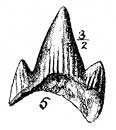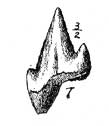Prev Page--Myliobatidae || Next Page--Lamnidae
Scyllidae
The family Scylliidae comprises small sharks with sharp-pointed cuspidate teeth, arranged in numerous series. The following genera are given by Woodward [Cat. Foss. Fishes Brit. Mus., I, p. 338.]: Paleoscyllium Wagner, Lower Kimmeridgian of Bavaria; Scylliorhinus Blainv., Turonian and Senonian; Pristiurus Bonaparte, Lower Kimmeridgian of Bavaria; Mesiteia Kramb., Senonian and Middle Eocene; Chiloscyllium Muller and Henle, Molasse; Crossorhinus Muller and Henle, Gault; Cantioscyllium Woodw., Turonian; Ginglymostoma Müller and Henle, Danaian, Eocene.
Numerous teeth from the Lower Cretaceous of Kansas seem in all probability to belong in this family, and agree pretty well, though rather large, with the teeth of Scylliorhinus, to which I refer them provisionally.
Scylliorhinus rugosus. Plate XXIV, fig. 5.
Scyllium rugosum [sic. rugosus] Williston, Kans. Univ. Quart., IX, p. 35.
Plate XXIV, Fig. 5--Scyllium rugosus Willist., enlarged.

Central cusp broad, pointed, nearly symmetrical, the cutting edges nearly straight, one of them a little longer than the other and slightly convex near the tip; a single pair of lateral denticles, which are nearly equilaterally triangular in shape; principal cusp with six or seven strong ridges on the basal two-fifths denticles with four or five similar ridges reaching two-thirds of the way to the apex; root narrow, apparently not at all produced at the angles; thinned and not at all tumid.
Type No. 1949, U.S. National Museum,
Greenleaf sandstone at Greenleaf ranch.
| Height of middle cusp | 7 mm |
| Width of same at base | 4 mm |
| Height of denticles | 3 mm |
| Width of same | 2 1/2 mm |
Scylliorhinus planidens. Plate XXIV, fig. 7.
Scyllium planidens Williston, Kans. Univ. Quart., IX, p. 35.
Plate XXIV, Fig. 7--Scyllium planidens Willist., enlarged.

Central cusp broad, pointed, convex from side to side, with sharp, non-crenulate edges; lateral cusps sharply pointed, smooth, two in number; root thin, narrow, moderately produced below the posterior denticle, smooth.
| Height of median cusp | 4 mm |
| Width of same at base | 3 mm |
| Width of base of tooth | 6 mm |
| Height of denticles | 1 1/2 mm |
Type No. 1949, U.S. National Museum. From same horizon as the preceding species.
I refer provisionally to this species numerous other specimens from the same horizon and collection. They differ in the relative size of the denticles, the more posterior direction of the main cusp, and the size. One tooth seems to lack the anterior denticle, which is always the smaller of the two; its absence may be due to injury.
Scylliorhinus (Lamna?) gracilis. Plate XXIV, fig. 6.
Scyllium (Lamna?) gracilis Williston, Kans. Univ. Quart., IX, p. 35.
Plate XXIV, Fig. 6--Scyllium (Lamna?) gracilis Willist., enlarged.

Main cusp elongate, slender; inner surface smooth, gently convex longitudinally, more so transversely, with sharp, smooth edges; the interior edge nearly straight, the posterior somewhat concave; denticles of nearly equal size, small, slender, acute; base narrow, prolonged into a slender root at each extremity.
| Height of tooth | 9 mm |
| Length of middle cusp | 6 mm |
| Width of same at base | 3 mm |
| Length of denticles | 2 mm |
One specimen, No. 1949, U.S. National Museum, with the preceding species.
Prev Page--Myliobatidae || Next Page--Lamnidae
Kansas Geological Survey, Volume V1, Cretaceous Fishes
Comments to webadmin@kgs.ku.edu
Web version July 2004. Original publication date 1900.
URL=http://www.kgs.ku.edu/Publications/Bulletins/Vol6/02_scyll.html